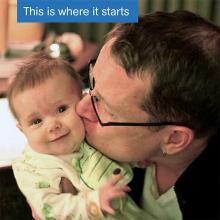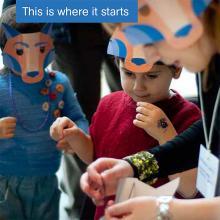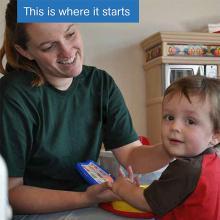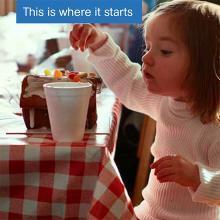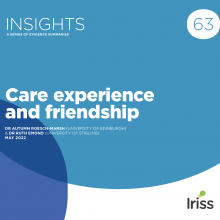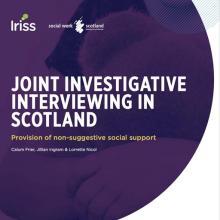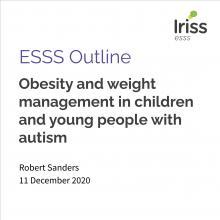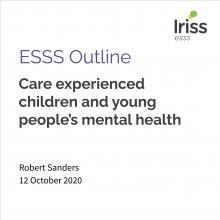This case study is part of This is Where it Starts, a collection of eight case studies on work with children and parents in early years. Case study six.
Background
Change Is a Must (CIAM) was developed in response to the local and national focus on early years, early intervention, and the increase in numbers of children on the Child Protection Register who are affected by parental substance misuse. CIAM reflects priority areas within Perth and Kinross Single Outcome Agreement, as well as national policy.
It addresses themes such as interagency working, inclusion, capacity and skills building. CIAM provides intensive support and assessment of families affected by parental substance misuse where the children are aged from pre-birth to eight years of age and deemed to be at significant risk of harm. CIAM began with a two-year pilot phase which brought together staff from Children's Services, Health Services and Drug and Alcohol services in a multi-agency team. The model of work is based on recent research findings (Ward et al, 2010) and designed accordingly to achieve effective interventions, engagement of parents of children deemed to be at significant risk and to ensure swifter decision making for these children. It draws on Adult Attachment Theory including assessment of parenting capacity within time-scaled, contract-based interventions involving the whole family. CIAM aims to ensure learning of best practice in work with families affected by parental substance misuse is rolled out across all agencies.
Funding (and costs where available)
- Funding: Two-year pilot was mainly funded by Perth and Kinross Council Alcohol and Drug Partnership (ADP) and Housing and Community Care with payments 'in kind' from Education and Children's Services. For this financial year (2012 / 2013), funding is mainly from Education and Children's Services and Housing and Community Care with a grant from the ADP.
- Costs: £147,139 per annum.
Size and number of staff
Service provides intensive support and assessment for up to 12 families at any one time from Perth and Kinross wide. Staff team consists of:
- I full time Team Leader
- 1 Senior Practitioner
- 1.5 Senior Social Care Officers
- 1 Social Worker (Social Work Child Care)
- 1 part time Community Support Worker, Drug and Alcohol Team, (Adult Care/Housing and Community Care)
- I part time Health Visitor
Referral routes
From any service, though mainly from Social Work Child Care but also Drug and Alcohol and Health Visitors through the Unborn Baby Protocol. Referral process:
- All referrers should arrange a meeting with Perth and Kinross Council Legal Services to check that a parenting capacity assessment is needed. If referrers do not have access to these services they should ask CIAM staff to arrange a meeting.
- All referrals will be screened through the Resource Panel (consisting of Improvement Officers from Children's Services). Referrers and other agencies can present the case to the Resource Panel.
- CIAM and Early Years Resource Team will be limited in the number of cases that can be held, and therefore, prioritisation will be given to families who are most in need and where children are assessed to be at significant risk. For CIAM case responsibility, in the main, will be transferred to Senior Practitioner at the CIAM Team. For Early Years Resource Team case responsibility will be retained by the Fieldwork Social Worker.
Key partners
Perth and Kinross Council Education and Children's Services, Housing and Community Care - Drug and Alcohol Team, Tayside Health Service, Perth and Kinross ADP
Established
2010.
The key messages from this case and quotes are drawn from the findings of a small-scale piece of research (Rioch,2011) on the impact of CIAM.
Key messages
Effective Integrated working is essential
CIAM is underpinned by effective integrated working based on shared goals, shared language, shared culture, shared information and shared effort. Examples of these include:
- Shared goals - protecting children is a central goal of all partners
- Shared culture/language - developing team value statements at the start of the project and joint training on a range of topics. Getting it Right for Every Child (GIRFEC) serves as the overarching framework.
- Shared effort - an action research model and pre and post intervention evaluation tools are built into the project which allows all partners/team members and importantly service users to contribute their views. This enables all involved to evaluate together the work undertaken, measure outcomes and adapt or change methods if required.
- Shared information - there are two weekly core groups for all families which all agencies and parents contribute to. This allows for information to be exchanged on a very regular basis and the process is transparent for parents.
Explore adults' attachment experiences
There is a strong evidence base around the importance of attachment and the negative impact on children's lives of insecure attachment between them and their primary caregiver. CIAM worked with parents to examine their own attachment experiences and how these might be impacting on their parenting capacity. Working from the perspective of adult attachment helped CIAM to achieve the following outcomes for parents:
- Improved self awareness
- Ability to make links between past experiences and current behaviour
- For some, improvements in parents' relationships with other adults in their lives
- Improvements in parents' ability to be mindful of their child. Feedback from parents highlighted the importance of reflection, promoted by the way support was being provided through CIAM. They found it 'helpful to reflect - that wasn't included in the previous assessment' and that 'previous assessment was...just basically parenting skills and that was it'. They also recognised that through reflection on their own lives, they became more aware of the impact of their behaviour on their parenting:
-
'I couldn't talk about my loss and guilt. This impacted on my parenting. I tried to protect my child by not telling him things.'
-
'I know reasons why my child behaved as he did. I know he didn't want to upset me - I put my fears onto my child'
-
'I've noticed my child is a lot better. My partner and I were having a lot of arguments and fighting a lot, sometimes it was physical. My child is a lot happier as she knows we are a lot happier'
-
Improved report writing and analysis support early decision making
Through CIAM, it was found that using adult attachment as a framework helped practitioners to meet best practice standards in writing comprehensive reports as outlined by research on serious case reviews (Brandon et al, 2008). These standards cover the following points:
- Good quality social and family histories including information about the parents' childhood, attachment, relationship, behavioural background and information about current wider family and environment
- Information about the child's needs, characteristics and behaviour
- Analysis of the interactive effect of vulnerabilities and risks (rather than static and/or descriptive accounts of incidents)
- Report is structured and coherent
- A clear case summary and synthesis of the knowledge brought together in the assessment
- A description of the problem or concern
- Description of protective factors and supports
- A hypothesis about the nature, origins and cause of the need/ problem or concern
- A plan of the proposed decisions and/or interventions
- Chronologies detailed enough to allow analysis of patterns / past behaviour over the years
More information was gathered from the parents which resulted in more in-depth assessment and analysis. Practitioners felt more informed and confident in evidencing parenting capacity which ultimately led to earlier decision-making - particularly important to improving outcomes of children affected by parental substance misuse.
Build a working alliance with parents
The impact on the working relationship between practitioner and parent was particularly striking. The adult attachment approach enhanced engagement between the parent and the professionals and enabled them to 'build a working alliance'. It promoted parental motivation and empowerment. One practitioner commented: 'it helps with blame culture - if they (the parents) understand why they act in certain ways, it helps them make sense of it.' One challenge identified by practitioners was that in some cases it could be difficult 'to help service users understand why you are using this approach'. However they also reflected that 'when it works well there is a sense of getting alongside someone - the approach engenders trust'. The study into the impact of CIAM uncovered a strong sense that parents liked an asset-based approach to support and recognised this as a different way of communicating with social services. Comments from parents included:
-
'my experience before was that social work just wanted to hear the bad things and didn't want to get involved, it's quite cold - this however is insightful'
-
'people are listening to you, taking their time...'
-
'...I realised there was support and help - social work are there to help as much as to protect and enforce the law, or can be anyway.'
Make time for practitioner reflection
Practitioners felt it was particularly important to build in time for reflection on their practice where they were working from a model of adult attachment and that this could be aided in supervision. They identified that objectivity in assessing and analysing parents' attachment experiences was essential and would require support through adequate reflection time and supervision.
Further information and references
Brandon M, Belderson P, Warren C, Howe D, Gardner R, Dodsworth J and Black J (2008) Analysing child deaths and serious injury through abuse and neglect: What can we learn? Nottingham: Department for Children, Schools and Families
Rioch C (2011) An adult attachment approach: Impact on parenting capacity assessments and building a working alliance with parents. MSc dissertation: University of Stirling.
Ward H, Brown R, Westlake D and Munro E (2010) Infants suffering, or likely to suffer, significant harm: A prospective longitudinal study, Loughborough: Centre for Child and Family Research, Loughborough University.

